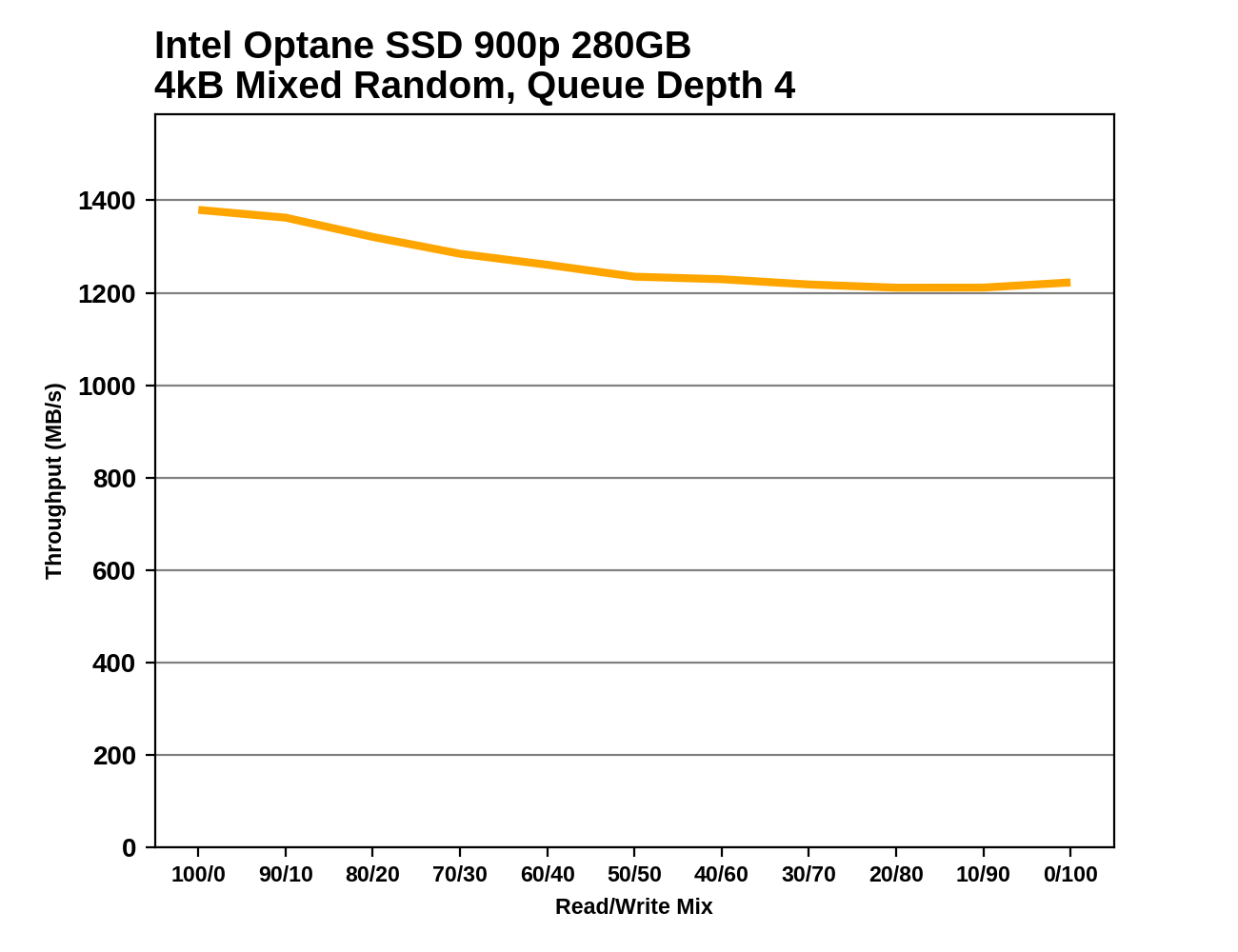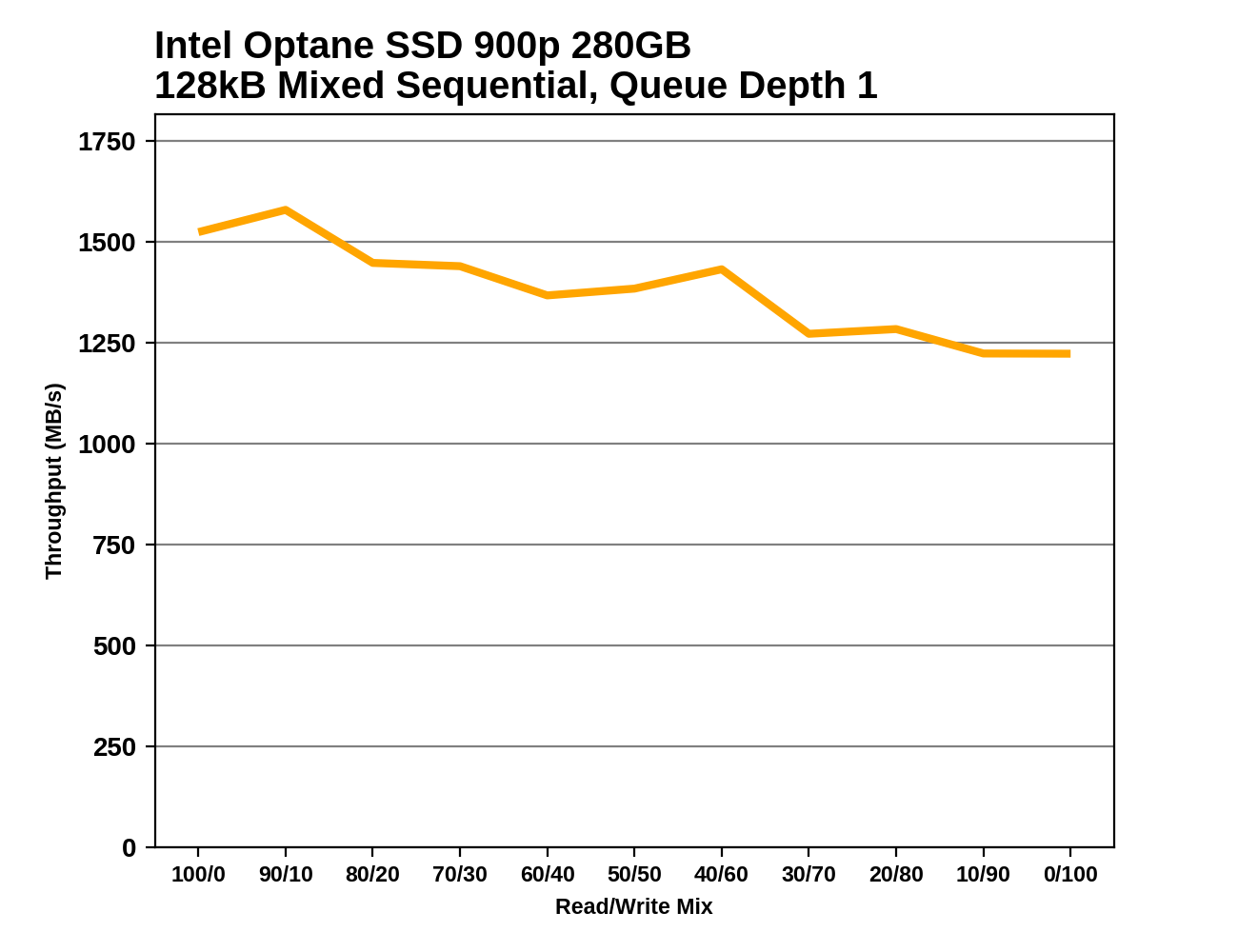The Intel Optane SSD 900P 280GB Review
by Billy Tallis on October 27, 2017 9:30 AM ESTMixed Random Performance
Our test of mixed random reads and writes covers mixes varying from pure reads to pure writes at 10% increments. Each mix is tested for up to 1 minute or 32GB of data transferred. The test is conducted with a queue depth of 4, and is limited to a 64GB span of the drive. In between each mix, the drive is given idle time of up to one minute so that the overall duty cycle is 50%.

The mixed random I/O performance of the Intel Optane SSD 900P is completely unmatched. The small Optane Memory M.2 is the second fastest drive we've tested, and the fastest flash-based SSD is only a third as fast as the Optane SSD overall.
 |
|||||||||
At the very end of the test, when the workload shifts to pure random writes, Samsung's fastest SSDs are able to batch the writes and dramatically improve throughput, almost enough to catch up to the slowest speed the Optane SSD hits during this test.
Mixed Sequential Performance
Our test of mixed sequential reads and writes differs from the mixed random I/O test by performing 128kB sequential accesses rather than 4kB accesses at random locations, and the sequential test is conducted at queue depth 1. The range of mixes tested is the same, and the timing and limits on data transfers are also the same as above.

The Intel Optane SSD 900P doesn't quite dominate the mixed sequential I/O test to the extent that it trounced the competition in the mixed random I/O test, but it still breaks the record with a 40% higher average throughput than the fastest flash-based SSD.
 |
|||||||||
The Optane SSD 900P's performance wavers a bit as the workload changes, but the general trend is a gradual reduction in performance as the proportion of writes increases. The flash-based SSDs tend to show an sharper decline in performance during the first half of the test, and the good ones recover most of that performance over the course of the second half. But the low performance in the middle of the test brings the averages way down and leaves the Optane SSD alone at the top.










205 Comments
View All Comments
investlite - Monday, November 6, 2017 - link
I bet you're still pissed we don't have flying cars. OMG, do you go to every new car unveiling and talk about how crappy each new car is because we were supposed to have flying cars by now?Gothmoth - Friday, October 27, 2017 - link
when you do huge particle simulations you will want the fastest SSD you can get.ddriver - Friday, October 27, 2017 - link
I've been doing that, for VFX as well as multiphysics simulations for over a decade. It has always been an in-memory thing. It doesn't seem they simulated it, it seems they read baked simulation data, and stored in some insanely inefficient manner at that.As I implied, this has got to be a new record in rigged benchmarks. Shame!
extide - Friday, October 27, 2017 - link
Sigh, the Optane drive didn't improve the performance of reading the data into the simulation. The simulation required (significantly?) more RAM than the system had. They put a big swap file on either a 960 PRO or on the Optane drive. It probably doesn't even matter where the simulation data was stored.ddriver - Friday, October 27, 2017 - link
Well, they should have bought moar ram then. Then maybe they could have kept that CPU busy at 100% and get much better time.I mean it is not like hypetane offers terabytes of capacity. Topping at 480 GB - that's entirely doable in RAM. More expressive - sure, but nonetheless a perfectly sensible investment if you are doing such simulations. It will pay for itself, as RAM is tremendously faster, and also doesn't wear, at least nowhere nearly as much as xpoint does.
extide - Friday, October 27, 2017 - link
For that particular case, sure, maybe more ram is the way to go, but there are plenty of cases where the drive is better, like several of the ones I mentioned above. Most of those rely on the non-volatile aspect, which obviously RAM doesn't have.ddriver - Friday, October 27, 2017 - link
As I said - it has its advantages and uses. I also said I might even buy it.And the only reason I call it hypetane is because intel shamelessly lied about it, and continues to cheat in order to make it look good even after it became evident that it is not anywhere nearly as good as they initially claimed, and call me old-fashioned, but I have a problem with that.
It boggles the mind that people around here have such a problem with me just because I don't have my tongue up intel's rectum...
ddriver - Friday, October 27, 2017 - link
BTW, 1.1 billion particles, presuming the simulation is ran in FP64 mode, with x y and z coordinates for each particle would only require about 24 gigs of ram.Which raises the question, did they allocate each of those points on the heap or something?
ddriver - Friday, October 27, 2017 - link
Opsie, silly me, it would take another 24gb for the vector of force for each particle. Now it is a little more plausible that 64gb might not be enough.CaedenV - Sunday, October 29, 2017 - link
Sure, in a perfect world you buy more RAM. But if you are in a situation where you don't have infinate cash and you can buy more RAM at $7/GB or an Optane SSD for ~$1-2/GB then Optane begins to look a bit more appealing. A 480GB drive running as cache for $600 vs 480GB of DDR4 at $3350.... that would make almost anyone thing twice.Or in the case of my work, we have a bunch of clustered servers, and we are maxxed out on ram but not yet ready to do a server upgrade (hoping to get 2 more years out of them), but we need more fast cache for a bunch of different applicaitons. The idea of running those caches on this kind of SSD sounds a lot more appealing than running on traditional SSDs.
But yes, when we upgrade servers, we will simply have more RAM on board. That is the obvious solution. But when a motherboard can only hold 256GB of RAM and you need more... life is often about compromises, and Optane tech sounds like a good compromise. But what you would use this for in daily life or in a normal computer? Man, that totally beats me! This product is almost too cheap for what it is good for (business class SSDs typically cost more than $1.25/GB still and are far slower than consumer SSDs), and completely useless and overpriced for that they are advertising it for.